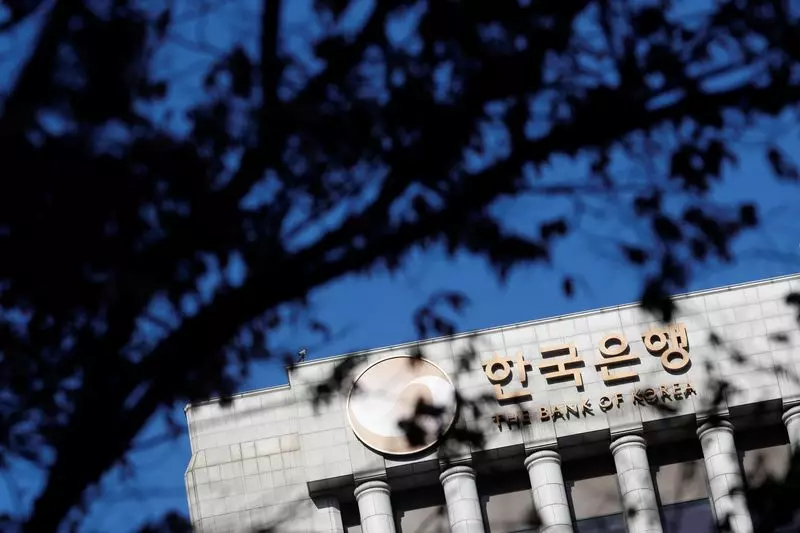In a significant yet unexpected move, South Korea’s central bank has lowered its benchmark interest rate, reflecting growing concerns over the nation’s economic stability. On a recent Thursday, the Bank of Korea opted for a second consecutive rate cut, bringing the interest rate down to 3.00%. This decision has taken many economists by surprise, with only four of the 38 analysts surveyed by Reuters anticipating such a move. The seven-member board of the central bank voted five-to-two in favor of the reduction, a clear indication of differing opinions within the panel, but it underscores the urgency of addressing faltering economic growth.
Governor Rhee Chang-yong elucidated that the shift is partly influenced by the uncertain economic climate created by Donald Trump’s re-election and its potential repercussions on trade. The governor expressed concerns about intensified export competition from other nations, adding that the board recognizes the mounting trade risks involved, which could exacerbate existing economic vulnerabilities.
The economic indicators in South Korea paint a concerning picture. The country narrowly avoided a technical recession in the third quarter, posting a mere 0.1% growth after previous contractions. The sluggish recovery in domestic consumption and lackluster export numbers contribute to this grim outlook. Furthermore, the possibility of higher tariffs, especially in the context of increasing tensions with China—which might face tariffs as high as 60%—adds another layer of complexity to South Korea’s trade dynamics.
Despite these hurdles, South Korea has recorded an astounding trade surplus of $44.4 billion with the United States in 2023, outpacing its surplus figures with other trading partners. This highlights the country’s very strategic trading relationship with the U.S., yet it also raises eyebrows about the future, particularly with the heightened unpredictability that could stem from Trump’s upcoming administration.
In light of these economic challenges, President Yoon Suk Yeol’s administration is taking strategic steps to safeguard pivotal sectors of the economy, with a spotlight on the local chip industry. The government’s announcement to bolster support for chipmakers signifies its recognition of this sector as a crucial driver of growth, especially when faced with potentially adverse policies from the future U.S. administration.
The tone set by Governor Rhee implies that more interest rate cuts could be on the horizon, as three of the board members displayed a willingness to consider further reductions in the upcoming months. Analysts, including Ahn Jae-kyun from Shinhan Securities, predict that another cut might occur in the first quarter of next year, suggesting a proactive approach from policymakers to stimulate economic activity.
The overarching economic landscape for South Korea involves cautious optimism mixed with significant anxiety. Increased fiscal measures might be on the agenda, with reports indicating plans for a supplementary budget to counterbalance the slowdown in consumer spending. Policymakers globally, including those in New Zealand, Canada, and Sweden, have been lowering interest rates to combat similar economic stagnation, revealing a trend of monetary easing aimed at reinvigorating sluggish economies.
With a downgrade in both growth and inflation forecasts by the Bank of Korea, expectations for economic expansion have weakened. The growth forecast was adjusted down to 2.2% from 2.4%, and the outlook for consumer inflation was lowered to 2.3%, down from 2.5%. These revisions reflect the realities of a challenging economic environment, pressuring the central bank to act decisively.
As South Korea navigates this precarious economic landscape, the implications of the central bank’s recent policy adjustments will become clearer in the months to come. The negative press on the won, Asia’s poorest-performing currency this year, adds to the urgency with which these measures are being considered. Governor Rhee’s assurance to cooperate with the government in stabilizing the foreign exchange market reinforces the commitment to safeguard economic interests.
South Korea’s economic path may be fraught with challenges, yet its leaders appear ready to confront these issues head-on with strategic monetary and fiscal policies. The central bank’s unexpected rate cut may be the beginning of a series of tactical maneuvers aimed at rekindling growth in an environment marked by uncertainty and competitive pressures from major trading partners. As these dynamics unfold, stakeholders will be watching closely to gauge the effectiveness of these measures in steering the economy back on course.

